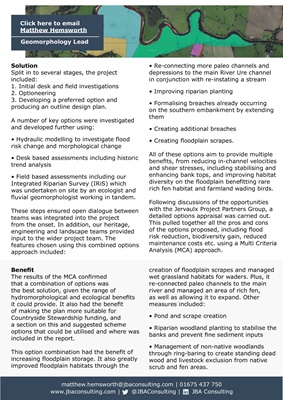
Solution
Split in to several stages, the project
included:
1. Initial desk and field investigations
2. Optioneering
3. Developing a preferred option and
producing an outline design plan.
A number of key options were investigated
and developed further using:
• Hydraulic modelling to investigate flood
risk change and morphological change
• Desk based assessments including historic
trend analysis
• Field based assessments including our
Integrated Riparian Survey (IRiS) which
was undertaken on site by an ecologist and
fluvial geomorphologist working in tandem.
These steps ensured open dialogue between
teams was integrated into the project
from the onset. In addition, our heritage,
engineering and landscape teams provided
input to the wider project team. The
features chosen using this combined options
approach included:
• Re-connecting more paleo channels and
depressions to the main River Ure channel
in conjunction with re-instating a stream
• Improving riparian planting
• Formalising breaches already occurring
on the southern embankment by extending
them
• Creating additional breaches
• Creating floodplain scrapes.
All of these options aim to provide multiple
benefits, from reducing in-channel velocities
and shear stresses, including stabilising and
enhancing bank tops, and improving habitat
diversity on the floodplain benefitting rare
rich fen habitat and farmland wading birds.
Following discussions of the opportunities
with the Jervaulx Project Partners Group, a
detailed options appraisal was carried out.
This pulled together all the pros and cons
of the options proposed, including flood
risk reduction, biodiversity gain, reduced
maintenance costs etc. using a Multi Criteria
Analysis (MCA) approach.
creation of floodplain scrapes and managed
wet grassland habitats for waders. Plus, it
re-connected paleo channels to the main
river and managed an area of rich fen,
as well as allowing it to expand. Other
measures included:
• Pond and scrape creation
• Riparian woodland planting to stabilise the
banks and prevent fine sediment inputs
• Management of non-native woodlands
through ring-baring to create standing dead
wood and livestock exclusion from native
scrub and fen areas.
Benefit
The results of the MCA confirmed
that a combination of options was
the best solution, given the range of
hydromorphological and ecological benefits
it could provide. It also had the benefit
of making the plan more suitable for
Countryside Stewardship funding, and
a section on this and suggested scheme
options that could be utilised and where was
included in the report.
This option combination had the benefit of
increasing floodplain storage. It also greatly
improved floodplain habitats through the
matthew.hemsworth@jbacosulting.com | 01675 437 750
www.jbaconsulting.com | @JBAConsulting | JBA Consulting
Click here to email
Matthew Hemsworth
Geomorphology Lead